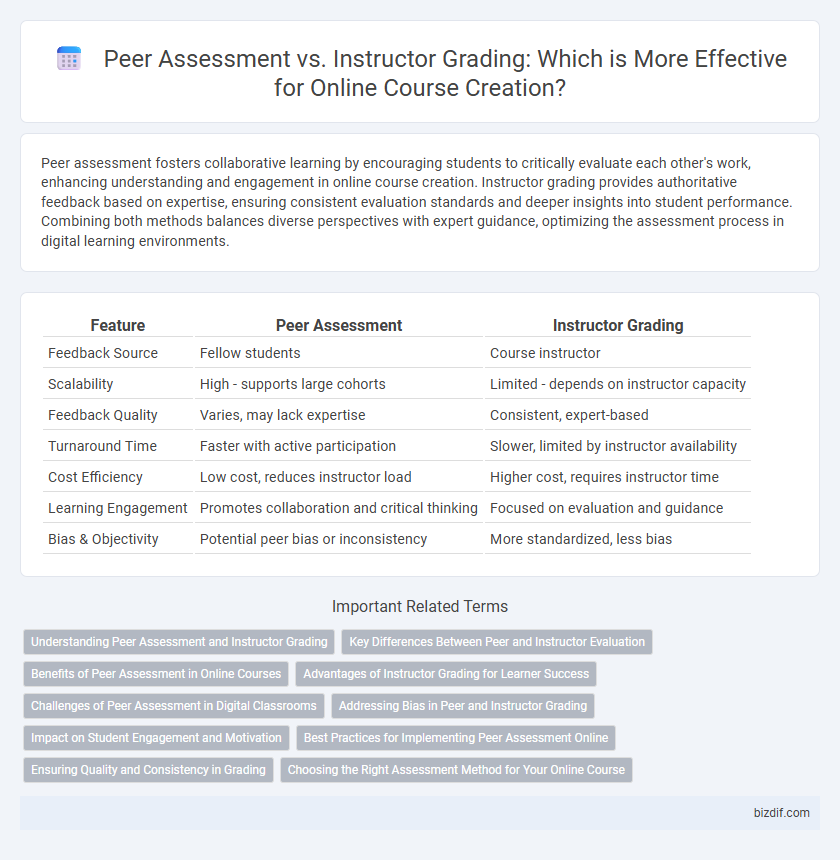Peer assessment fosters collaborative learning by encouraging students to critically evaluate each other's work, enhancing understanding and engagement in online course creation. Instructor grading provides authoritative feedback based on expertise, ensuring consistent evaluation standards and deeper insights into student performance. Combining both methods balances diverse perspectives with expert guidance, optimizing the assessment process in digital learning environments.
Table of Comparison
| Feature | Peer Assessment | Instructor Grading |
|---|---|---|
| Feedback Source | Fellow students | Course instructor |
| Scalability | High - supports large cohorts | Limited - depends on instructor capacity |
| Feedback Quality | Varies, may lack expertise | Consistent, expert-based |
| Turnaround Time | Faster with active participation | Slower, limited by instructor availability |
| Cost Efficiency | Low cost, reduces instructor load | Higher cost, requires instructor time |
| Learning Engagement | Promotes collaboration and critical thinking | Focused on evaluation and guidance |
| Bias & Objectivity | Potential peer bias or inconsistency | More standardized, less bias |
Understanding Peer Assessment and Instructor Grading
Peer assessment enables learners to evaluate each other's work, fostering critical thinking and providing diverse feedback, which enhances engagement and improves comprehension in online courses. Instructor grading offers expert evaluation, ensuring consistent standards and authoritative feedback critical for maintaining academic rigor. Combining peer assessment with instructor grading balances collaborative learning with professional oversight, optimizing the educational experience.
Key Differences Between Peer and Instructor Evaluation
Peer assessment encourages collaborative learning by allowing students to evaluate each other's work, promoting diverse feedback and critical thinking. Instructor grading offers expert evaluation with standardized criteria, ensuring consistency and authoritative judgment in assessing student performance. The key differences lie in the source of feedback, objectivity, and potential bias, where peer assessments foster engagement while instructor grading provides reliability and accountability.
Benefits of Peer Assessment in Online Courses
Peer assessment in online courses fosters critical thinking and deeper engagement by encouraging students to evaluate diverse perspectives and articulate constructive feedback. It promotes collaborative learning and enhances communication skills, creating a more interactive and participatory educational environment. This method also alleviates instructor workload, allowing for more timely feedback and scalability in large online classes.
Advantages of Instructor Grading for Learner Success
Instructor grading ensures consistent and expert evaluation, offering learners personalized feedback that directly targets their progress and improvement areas. This authoritative assessment method fosters higher engagement and motivation by providing clear standards and accountability. Learners benefit from the instructor's deep subject knowledge, which enhances the credibility and reliability of the grading process, driving better learning outcomes.
Challenges of Peer Assessment in Digital Classrooms
Peer assessment in online course creation faces challenges such as inconsistent grading standards and potential bias among students, which can affect the reliability of evaluations. Digital classrooms may struggle with ensuring timely and constructive feedback, as students vary in their engagement and assessment skills. Integrating technological tools that support rubrics and calibration exercises can help mitigate these issues but require significant instructor oversight and training.
Addressing Bias in Peer and Instructor Grading
Peer assessment and instructor grading both face challenges in addressing bias, but implementing standardized rubrics and anonymized submissions helps reduce subjective influence in each method. Peer assessments can benefit from calibration exercises to align evaluators' standards, while instructor grading can be enhanced through blind grading and diversified instructor panels to minimize unconscious bias. Combining multiple grading sources and data analytics improves fairness and accuracy in online course evaluation systems.
Impact on Student Engagement and Motivation
Peer assessment fosters collaborative learning and increases student engagement by encouraging active participation and critical thinking, as learners evaluate and receive feedback from their peers. Instructor grading provides authoritative evaluation that can motivate students through clear expert feedback and structured guidance, but may limit opportunities for peer interaction and self-reflection. Balancing peer assessment with instructor grading creates a dynamic learning environment enhancing motivation and deepening comprehension in online course creation.
Best Practices for Implementing Peer Assessment Online
Implementing peer assessment in online course creation enhances student engagement and develops critical evaluation skills when clear rubrics and guidelines are provided to ensure consistency and fairness in grading. Establishing anonymous submissions and structured feedback mechanisms reduces bias and promotes honest, constructive critiques. Incorporating instructor oversight to review peer evaluations improves assessment accuracy and supports students in understanding grading expectations effectively.
Ensuring Quality and Consistency in Grading
Peer assessment enhances scalability and engagement in online course creation, allowing diverse learner perspectives to enrich evaluation. Instructor grading ensures expert oversight and maintains high standards of quality and consistency across submissions. Combining both methods leverages the flexibility of peer input with the reliability of instructor expertise, resulting in balanced and accurate assessment.
Choosing the Right Assessment Method for Your Online Course
Peer assessment fosters collaborative learning by encouraging students to evaluate each other's work, enhancing critical thinking and engagement. Instructor grading provides expert feedback and maintains consistent standards, ensuring accurate evaluation of student performance. Selecting the right assessment method depends on course goals, class size, and the need for scalability versus personalized feedback in your online course.
Peer assessment vs Instructor grading Infographic

 bizdif.com
bizdif.com